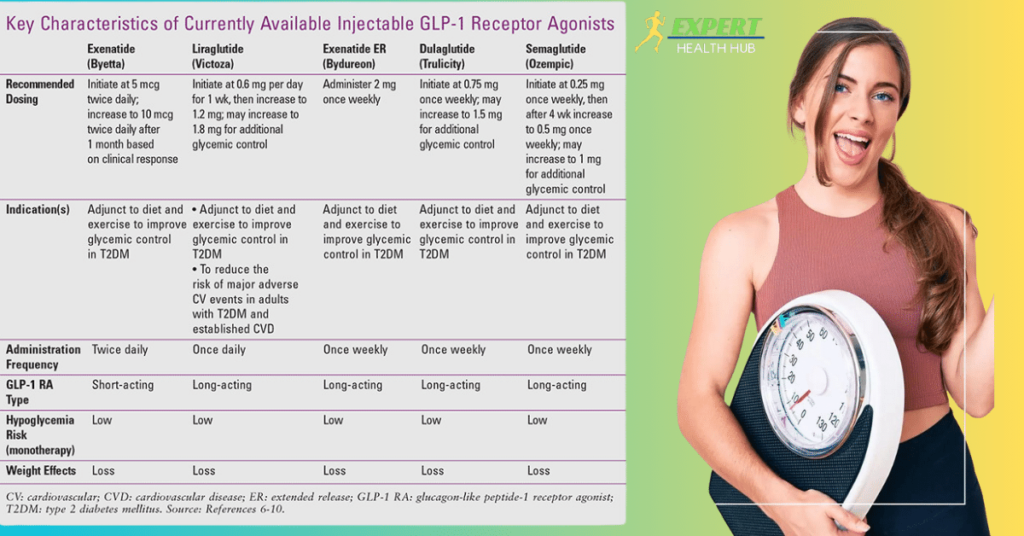Semaglutide for weight loss in non diabetics dosage
Semaglutide for weight loss in non diabetics dosage
Introduction:
If you are interested in learning the Semaglutide for weight loss in diabetics dosage then your search has ended. In this article, you learn completely about Semaglutide for weight loss in dosages.
Table of Contents
Starting a weight loss journey can frequently be likened to negotiating a maze, full of options and unknowns. However, in the middle of this confusion, semaglutide shows promise for people looking to lose weight without having to deal with the burden of diabetes.
We examine the complex mechanisms, dosages, advantages, and possible drawbacks of semaglutide in this in-depth guide, providing clear explanations.
Pro Tip: Learn more about kelly o’ donnell lose weight
1. Deciphering Semaglutide for Weight Management

a. Unveiling its Mechanism:
Analogous to the hormone glucagon-like peptide-1 (GLP-1), semaglutide controls blood sugar levels and postprandial hunger. Similar to GLP-1, semaglutide promotes gradual weight loss by enhancing fullness perception while decreasing food consumption.
b. Dosage Directives:
For weight management, a weekly subcutaneous injection of 2.4 mg of semaglutide is the typical dosage. Healthcare providers establish customized dosages depending on patient characteristics such as weight, medical history, and reaction to treatment.
c. Advantages and Efficacy:
Research exhibits that semaglutide is compelling in assisting individuals with losing a lot of weight who are overweight or fat, whether or not they have diabetes. Throughout the year, members experienced upgrades in their glucose and cholesterol levels, notwithstanding a normal weight reduction of 15-20%.
Pro Tip: Learn more about How Did Oprah Lose Weight?
2. Exploring Semaglutide’s Branding and Diverse Forms
a. Brand Diversification:
Semaglutide is commercially available under various brand names, including Ozempic and Wegovy, all of which contain the same active ingredient, albeit potentially differing in formulations or packaging.
b. Array of Variants and Formulations:
Predominantly dispensed in injectable form, semaglutide manifests in different potencies, with the 2.4 mg weekly injection being prevalent for weight loss. Alternative formulations cater to type 2 diabetes management.
c. Comparative Analysis with Counterparts:
Medications like liraglutide and semaglutide are linked since they are both GLP-1 receptor agonists. However, semaglutide is the most efficient weight loss medicine among all options.
Pro Tip: Learn more about All Factors That Influence Our Physical Fitness Can Be Controlled
3. Scrutinizing Semaglutide’s Hazards and Adverse Effects

a. Common Ailments:
Most frequently, semaglutide causes gastrointestinal distress, vomiting, diarrhea, and constipation. These adverse effects normally fade away after a while as the body becomes used to the medication.
b. Infrequent yet Grave Perils:
Semaglutide rarely causes major side effects such as allergic reactions or pancreatitis, which requires prompt medical intervention when symptoms arise.
c. Precautionary Measures and Safety Protocols:
Prior to Semaglutide commencement, meticulous disclosure of medical history, especially concerning pancreatitis or thyroid disorders, is imperative. Close monitoring during Semaglutide therapy ensures patient safety.
Pro Tip: Learn more about A sedentary job is one that requires physical exertion.
4. Semaglutide Integration into Non-Diabetic Weight Loss Regimens
a. Inclusion in Weight Management Plans:
Semaglutide serves as a pivotal component in holistic weight loss strategies encompassing dietary modifications, physical activity, and behavioral adjustments. While not a panacea, it complements weight loss endeavors efficaciously.
b. Facilitating Lifestyle Amendments:
When combined with the administration of semaglutide, lasting lifestyle changes, such as eating a balanced diet and exercising on a regular basis, become extremely important for attaining long-term weight loss results.
c. Synergistic Therapeutic Approaches:
In select scenarios, combining Semaglutide with adjunctive weight loss modalities or medications may amplify its efficacy. However, such amalgamations warrant judicious oversight by healthcare professionals.
Pro Tip: Learn more about Household chores are a good way to fit exercise into your everyday routine.
5. Navigating Semaglutide Dosage and Administration Guidelines
a. Standard Adult Dosage for Weight Management:
Semaglutide’s recommended dosage for weight loss stands at 2.4 mg weekly, adhering closely to healthcare provider directives to optimize therapeutic benefits.
b. Frequency of Administration:
Administered on a weekly basis, Semaglutide injections afford flexibility, enabling patients to adhere to a consistent schedule for optimal outcomes.
c. Injection Technique and Administration Protocols:
Adeptness in Semaglutide injection techniques is paramount, necessitating meticulous adherence to healthcare provider instructions to ensure accurate dosing and mitigate injection site reactions.
Pro Tip: Learn more about Overall, you need to take responsibility for your physical fitness
6. Long-Term Impacts and Sustainability of Semaglutide Weight Management
a. Sustaining weight loss achievements:
Evidence corroborates the sustenance of Semaglutide-induced weight loss over protracted durations with continued treatment. However, perpetuating healthy lifestyle practices remains instrumental in thwarting weight gain.
b. Metabolic Health Enhancements:
Semaglutide reduces body weight and also has positive effects on blood glucose and lipid profiles, which lowers the risk of type 2 diabetes and cardiovascular disease.
c. Preserving Sustained Health Outcomes:
Embracing Semaglutide as a proponent of sustained weight loss mandates steadfast adherence to lifestyle modifications, constituting a holistic approach encompassing dietary vigilance, physical activity, and stress management.
Pro Tip: Learn more about Kill Tooth Pain Nerve in 3 Seconds Permanently
7. Special Considerations in Semaglutide Therapy

a. Patient Selection Criteria:
Semaglutide candidacy extends to individuals grappling with obesity or overweight status, particularly those encountering futile weight loss attempts. Patient eligibility hinges on meticulous evaluation by healthcare providers, factoring in medical history and therapeutic objectives.
b. Monitoring and follow-up imperatives:
Rigorous monitoring during Semaglutide therapy enables healthcare providers to calibrate treatment regimens judiciously, ensuring optimal outcomes. Consistent engagement in follow-up consultations is pivotal in navigating the weight loss trajectory.
c. Adherence Promotion Strategies:
Optimal Semaglutide outcomes pivot on strict adherence to prescribed regimens and healthcare provider recommendations. Implementation of adherence promotion strategies, encompassing regimen adherence tracking and lifestyle coaching, augments treatment efficacy.
Pro Tip: Learn more about Extreme Tooth Pain Can’t Sleep
8. How Semaglutide Affects Other Health Conditions
a. Control the diabetes:
Semaglutide has many uses, one of which is helping people with type 2 diabetes better manage their blood sugar levels. This results in fewer complications caused by diabetes and less need for additional antidiabetic medications.
b. Strengthening the Heart:
For those who are overweight and have risk factors for cardiovascular disease, semaglutide is a promising treatment option since it reduces the likelihood of unfavorable cardiac events such as myocardial infarction, stroke, and cardiovascular death.
c. Handling Multiple Illnesses at Once:
Thanks to its ability to reduce weight and improve metabolic health, semaglutide shows potential for treating conditions including sleep apnea and non-alcoholic fatty liver disease (NAFLD). Semaglutide is thus a key figure in improving health outcomes generally.
Pro Tip: Learn more about Should I take meloxicam at night or in the morning?
9. The Function of Semaglutide in Reducing Obesity-Related Illnesses

a. Reducing Cardiovascular Risk Factors:
The reduced risk of hypertension, dyslipidemia, and cardiovascular disease is a direct result of semaglutide’s ability to promote weight loss while simultaneously improving metabolic abnormalities.
b. Preventing Diseases Caused by Excess Fat:
In addition to preventing obesity-related diseases, including type 2 diabetes and cardiovascular problems, semaglutide also protects against specific cancers, which means better health outcomes overall.
c. Propensity for Long-Term Health Benefits:
By instigating sustained weight loss and metabolic equilibrium, Semaglutide holds promise for conferring enduring health dividends, thereby potentiating a paradigm shift in the management of obesity and its attendant complications.
Pro Tip: Learn more about How to Lose Weight Fast In 2 weeks 10 Kg
10. Future Trajectories and Research in Semaglutide Therapy
a. persistent clinical investigations:
Semaglutide’s therapeutic landscape continues to evolve through ongoing clinical inquiries, delineating its efficacy in diverse realms spanning weight management, diabetes care, and ancillary health spheres.
b. Expanding Horizons of Semaglutide:
In tandem with weight loss and diabetes control, Semaglutide’s burgeoning applications encompass a spectrum of disorders encompassing polycystic ovary syndrome (PCOS), chronic kidney ailments, and neurodegenerative pathologies, signifying a realm of untapped therapeutic potential.
c. Forging Ahead in Semaglutide Innovation:
Anticipated developments in Semaglutide therapy encompass novel formulations, dosing paradigms, and administration modalities, promising heightened accessibility and convenience for patients, thereby broadening its therapeutic reach and societal impact.
Pro Tip: Learn more about How to lose belly fat after breast reduction

Conclusion:
You learn completely about, Semaglutide for weight loss in non diabetics dosage. In the quest for health and vitality, semaglutide emerges as a reliable companion, going beyond the confines of traditional weight reduction drugs. With a thorough grasp of Semaglutide’s complexities, individuals starting their weight reduction journey can move forward with confidence and clarity.
Never hesitate to seek counsel or clarification from your healthcare professional; they are standing by to help you every step of the way. If you have any questions related to Semaglutide for weight loss in non diabetics dosage ask me in the comment section.
Pro Tip: Learn more about White claw nutrition facts?
FAQs: About Semaglutide for Non-Diabetic Weight Loss:
Q: Does Semaglutide facilitate weight loss in non-diabetic individuals?
Certainly! Semaglutide has demonstrated efficacy in promoting weight loss among non-diabetic cohorts, facilitating the shedding of surplus pounds, and fostering holistic health enhancement.
Semaglutide is a member of the GLP-1 receptor agonist class and is related to drugs such as liraglutide. However, within this group, semaglutide stands out as the most effective weight-loss medication.
Q: What are the common side effects associated with Semaglutide?
Typical Semaglutide side effects encompass transient gastrointestinal disturbances such as nausea, stomach upset, or diarrhea. However, these manifestations typically abate with continued medication usage.
Q: Is Semaglutide superior to alternative weight loss medications?
Semaglutide exhibits promising outcomes in weight reduction, particularly when juxtaposed with other pharmacotherapeutic agents. However, individual responses may vary, necessitating tailored therapeutic approaches in consultation with healthcare providers.
Q: How is Semaglutide administered?
Semaglutide is typically administered via a once-weekly subcutaneous injection regimen, affording convenience and ease of incorporation into daily routines. Your healthcare provider will furnish detailed instructions on correct administration techniques.
Q: Can Semaglutide be combined with other weight loss interventions?
In select scenarios, Semaglutide may be synergistically integrated with adjunctive weight loss modalities or medications to augment therapeutic efficacy. Nonetheless, such amalgamations mandate prudent oversight and supervision by healthcare professionals.
Pro tip: To learn more about health and fitness-related knowledge, regularly visit Quora, Linked, Twitter, Pinterest, Instagram, YouTube, and Facebook.






